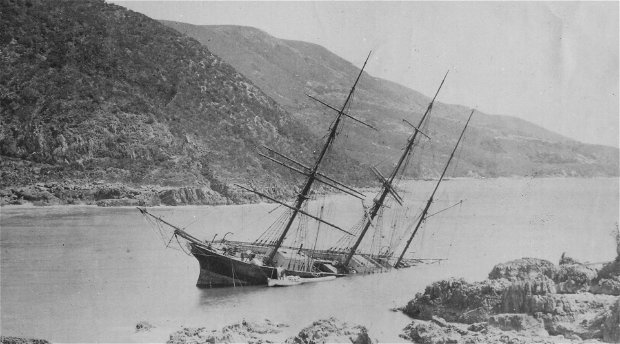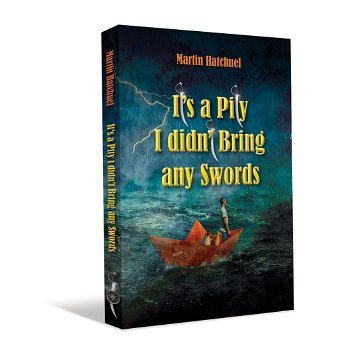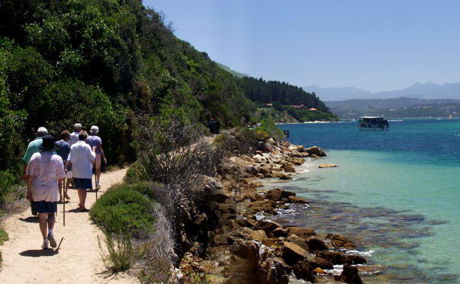Knysna’s Trent Read has been involved in the business of art for 50 years.
Will the Paquita sail again? Yes - in this ghoulishly lekker Knysna adventure story

Will the wreck of the 19th Century ship, the Paquita, sail again in the 21st Century? And more importantly: why?
The Paquita was a 460-ton barque (three-masted sailing vessel) that was built in England in 1862, and that was wrecked near the beacon on Knysna’s Eastern Head - probably deliberately - on the 18th of October, 1903.
But then it sailed again just recently - in Martin Hatchuel’s ghoulishly lekker local adventure, ‘It’s a pity I didn’t bring any swords.’
So what’s the story?
Wreck of the Paquita
The Paquita - in Spanish, ‘Paquita,’ is the familiar form of the name, Francisca, and ironically means, ‘free’ - had already had a long career as a cargo ship when it left England for Knysna in April 1903, carrying a load of coal destined for the sawmillers, Thesen & Co.
As a sailing ship, the Paquita was one of the last of its kind.
A steel-hulled vessel with no engines (steam or otherwise), it was configured in the classic style of a 3-masted barque. Its mainmast (tallest mast) and foremast were square rigged (with square sails that hung from wooden yardarms), and its mizzenmast (rear mast) was fore-and-aft rigged - that is, it had a pair of sails that followed the centre-line of the ship, and that, seen together, formed an almost triangular-shape.
On that final voyage, the Paquita arrived off Knysna in July 1903, but, finding the conditions at The Heads unfavourable, sailed off and anchored in Plettenberg Bay to wait for better days.
On the 19th of August, the ship finally entered the Knysna Lagoon, and tied up at Thesen’s Wharf, where its cargo was offloaded. It was then moved to a spot on the Brenton shore known as ‘The Sandpit,’ where its holds were loaded with sand as ballast in preparation for its onward journey.
From then on, things seemed to become a little dodgy. On the 3rd of October - apparently because the anchor had failed as a result of strong winds - the ship ran aground on Leisure Isle (then known as Steenbok Island) on the eastern side of the lagoon.
In order to float it again, the crew threw the ballast overboard - but another gale blew up on the 18th of October, and the anchor cables “failed" again (“parted” in the parlance), apparently causing the ship to drift up against Fountain Point on the Eastern Head, where it was was holed by the rocks and began to sink.
Salvaging the Paquita
Couple of strange points: although the Paquita was supposed to have been preparing for a long onward journey, most of the crew had been paid off or had deserted while they were here in Knysna, and only four were left - which wasn’t nearly enough for a ship that would have needed at least ten pairs of hands.
And secondly: when a diver went down to place explosives against the hull to finally sink the hulk - he found all the cables intact, and, in fact, reported that the anchor had been deliberately placed to hold the ship against the rocks.
So no, the insurance didn’t pay out…
The wreck was sold at auction, although the buyers weren’t able to save much of it. Apparently the man who bought the hull - he paid £30 for it - couldn’t even salvage the steel, and only managed to get the ship’s ropes off the wreck. But Donald Benn (assistant pilot from 1888 to 1912) did get hold of the topmast, which he repurposed as a flag pole - but not the flagpole that features in ‘It’s a pity I didn’t bring any swords.’
For the rest, the remains of the old tub sank gradually - over a period of 18 months - to the bottom, until the Paquita became only a shadow visible from the land. And, now that it’s covered in colourful corals and such, an attractive spot for scuba diving and snorkelling.
It’s a pity I didn’t bring any swords
But how does the Paquita feature in the story of a boy and his friend the ghost who sail off into the night to search for the ghost’s lost grandpa, who’d last been seen haunting a shipwreck on Noetzie Beach, east of the Knysna Heads, 140 years ago?
Well, that’s a complicated question to answer in a short article like this one - but all will be revealed when you read the book!
Editor and book designer
‘It’s a pity I didn’t bring any swords' is edited by Mike Kantey of Watercourse, Plettenberg Bay, with cover design and book design by Christian Jaggers of OneDesign, Cape Town.
Further Reading
Total commitment and a love for animals drives this Plettenberg Bay woman to try and change the law about whether animals can own the land on which they live, and so protect their habitat forever.
Opened to guests in 1984, Knysna’s Featherbed Nature Reserve quickly grew into one of the Garden Route’s biggest tourism attractions. Martin Hatchuel takes a look at its origins and early history under its founder, William Smith. Please scroll down for a gallery of pics.




Share This Post